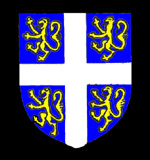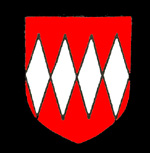Volume II of The Victoria County History for Bedfordshire, published in 1908, gives the histories of all the five manors in Clophill as far as they were known at the time. The Manor of Clophill and Cainhoe has its origins in the two manors held at the time of Domesday Book by Nigel de Albini one, as the name suggests in Clophill, which had five hides and the other in Cainhoe, which had four hides. The overlordship of this manor was held by the Honour, or Barony, of Cainhoe until the reign of King Henry VIII (1509-1547) when he annexed the manor to the new Honour of Ampthill in 1542, which was designed to maintain a royal palace in Ampthill which was never built.
The Manor of Clophill and Cainhoe was held by the de Albini family without a tenant until 1233 when the last de Albini male died and his possessions were divided amongst his three sisters, Clophill and Cainhoe Manor going to his eldest sister Isabel, wife of William de Hocton and, after his death, Drew des Preaux. Her son William must have assumed the name de Albini as he is known by that name when he succeeded his mother in 1262. His son Simon died in 1272 and the manor was then divided between his three sisters Isabel, Christina and Joan.

The Dakeney family coat of arms
The youngest sister, Joan married three times and by her second husband Sir Roger Dakeney left a son, Robert, to whom her third share descended after her death in 1310. He died in 1316. He later acquired a further ninth of the manor.
Isabel married Hugh de Saint-Croix and later William de Hotot. Her son Peter de Saint-Croix succeeded and died, along with his son, perhaps of the Black Death in 1349 (the year it first entered England), certainly the Victoria County History states: "In 1349 his estate suffered severely from the plague, all the bondmen and cottars dying of the pestilence". His second son Thomas inherited and in 1362 alienated his third of the manor to Sir John Cheyne, with a remainder to John Dakeney.
The third of the manor which went to Christina was divided into further thirds (ninths of the whole manor) on her death in 1318, going to her three daughters by Peter de la Stane - Elizabeth, Margery and Christina. Christina married Anthony de Byddik and died in 1326 and she was succeeded by her son John de Mere, who granted it to John Dakeney for life in 1334, John acquiring full possession in 1336. Elizabeth's son Peter de Norton inherited her ninth of the manor and, on his death, his brother Thomas received it, but alienated it to John Dakeney in 1334. It then reverted to Thomas' son and he sold it to John Dakeney in 1373. Margery's son Brian Saffey inherited her ninth share but died, probably of Black Death, in 1349. His uncle Thomas Saffey then succeeded to it and it passed to his sister Joan in 1361 and she, in 1364, alienated it to John Dakeney.
When he purchased Elizabeth de la Stane's ninth of the manor in 1373 John Dakeney thus gained possession of the whole of it. Ironically, he died three years later and his son died as a minor in 1384, the manor passing out of the family, to John's sister Alice, wife of Walter Alnthorpe. Between 1415 and 1428 the manor was alienated to Reginald de Grey. The manor remained in this family until Richard de Grey, Earl of Kent, sold it to Giles, Lord Daubeny some time during the reign of Henry VII (1485-1509).

The Daubeny family coat of arms
The Victoria County History states that Lord Daubeny's son probably sold the manor to Sir William Compton and, on his death, in 1528 it reverted to the Crown under the terms of Sir William's will. In 1542 it was annexed to the Honour of Ampthill, as noted above.
In 1548 the manor was leased by the Crown to William Cartwick for twenty one years. In 1558 the lease was granted to Robert Beverley. In 1572 the manor was in the hands of Thomas Newdigate, he had bought it from Henry and George Fisher, who had it from Robert Power. In 1607 Thomas, Viscount Fenton received the manor for forty one years, Edward, Lord Bruce receiving the lease in 1613. In 1624 James I granted the lease for ninety nine years to Sir Henry Hobart and others in trust for the Prince of Wales, later Charles I (1625-1649). The reversion of this lease was sold to James Beverley in 1628. In 1654 he alienated it to Amabel, Dowager Duchess of Kent. The manor, along with Beadlow and Clophill Hall, remained in the possession of her heirs (Lord Lucas and Dingwall by the 20th century) until a succession of Law of Property Acts in the 1920s abolished manorial fines and incidents as well as copyhold land tenure, thus abolishing manors in practically all but name.